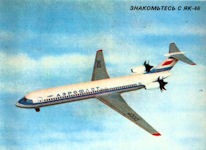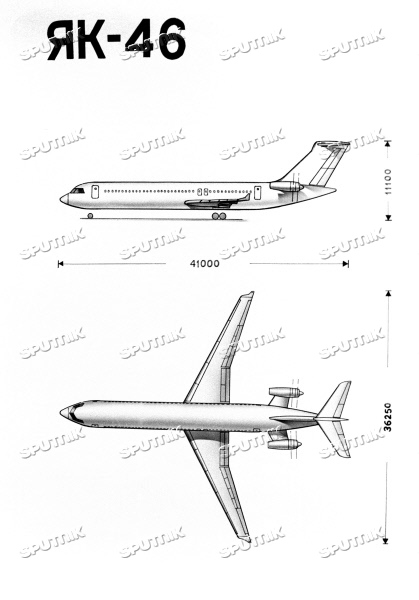Yak-46 [Second]
 In 1985, the Yak-46 index was re-used for another project for a passenger aircraft OKB Yakovleva: on the first of them prospective D-27 prop-fans were to be used, on the other, which later received their own Yak-242 index, D-90 (PS-90) engines. The first flight of the experimental aircraft was planned for 1995. Operation on the air lines of the variant with the turbofan engine can begin in 1996-1997, the variant with the fuel engine - after 2000. In the late 1980s, OKB im. Tupolev resorted to a similar development scheme for the Tu-334 short-haul airliner, taking the already flying Tu-204 as the basis for the new aircraft . However, according to the layout of the cabin, the tail unit and the type of engines used, the Tu-334 resembled the slightly enlarged Yak-46 of the 1982 project.
In 1985, the Yak-46 index was re-used for another project for a passenger aircraft OKB Yakovleva: on the first of them prospective D-27 prop-fans were to be used, on the other, which later received their own Yak-242 index, D-90 (PS-90) engines. The first flight of the experimental aircraft was planned for 1995. Operation on the air lines of the variant with the turbofan engine can begin in 1996-1997, the variant with the fuel engine - after 2000. In the late 1980s, OKB im. Tupolev resorted to a similar development scheme for the Tu-334 short-haul airliner, taking the already flying Tu-204 as the basis for the new aircraft . However, according to the layout of the cabin, the tail unit and the type of engines used, the Tu-334 resembled the slightly enlarged Yak-46 of the 1982 project.
Modifications included a turbofan engine of an extra large degree of bypass and with a high-pressure fuel pump. Dimensions (in brackets for the TVVD variant) were wingspan 36.25 (35.50) m; aircraft length 38.00 (41.00) m; aircraft height 12.85 (11.00) m; wing area 120 m 2 ; wing sweep angle along the 1/4 chord line 25 °; wing extension 10.5; fuselage diameter 3.8 m. The number of places for passengers was 156 (basic version) or 150, depending on the layout of the seats.
The Turbofan engine D-627 of the Zaporizhzhya ICD “Progress” of an extra-large bypass ratio with reversing devices (2x115.7 kN, 2HP 800 kgf). A high-pressure fuel pump (2X109.8 kN, 2X11 200 kgf) of a gearbox with pushing coaxial rotor fans with a diameter of 3.8 m is being developed by the Zaporozhye MKB Progress on the basis of D-27.
Masses and loads (in brackets for the variant with fuel injection engine) were maximum take-off 63,000kg (61,300kg); empty equipped aircraft 37,630kg (37,680 kg); payload: maximum 17,500 kg, normal 14,250 kg. Cruising speed was 830 (800) km / h at an altitude of 11 100 (11 400) m; required runway length 2200 m; practical flight range: with a maximum payload of 2,470 (1,600) km, with a normal payload of 3,230 (3,300) km; maximum aerodynamic quality 18.
The wing had a supercritical profile and vertical end aerodynamic surfaces. The TsPNK-46 digital flight and navigation system provides automatic landing according to ICAO Category IIIA, automatic aircraft navigation along 70 programmed routes with a predetermined arrival time according to a schedule, includes a system for optimizing flight modes and engine operation, and CRT color indicators. The four-redundant electric remote-control flight control system made it possible to implement a scheme with a small margin of longitudinal static stability at cruising flight regimes (stability coefficient 0.05-0.07), and there is a system to prevent it from reaching critical flight regimes.

|
NEWSLETTER
|
| Join the GlobalSecurity.org mailing list |
|
|
|

